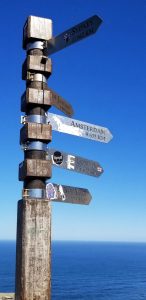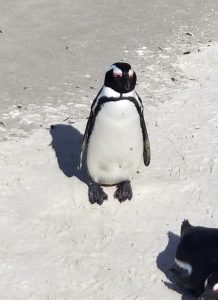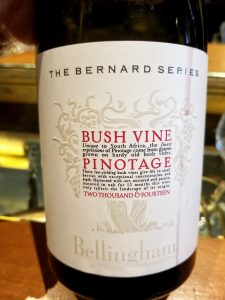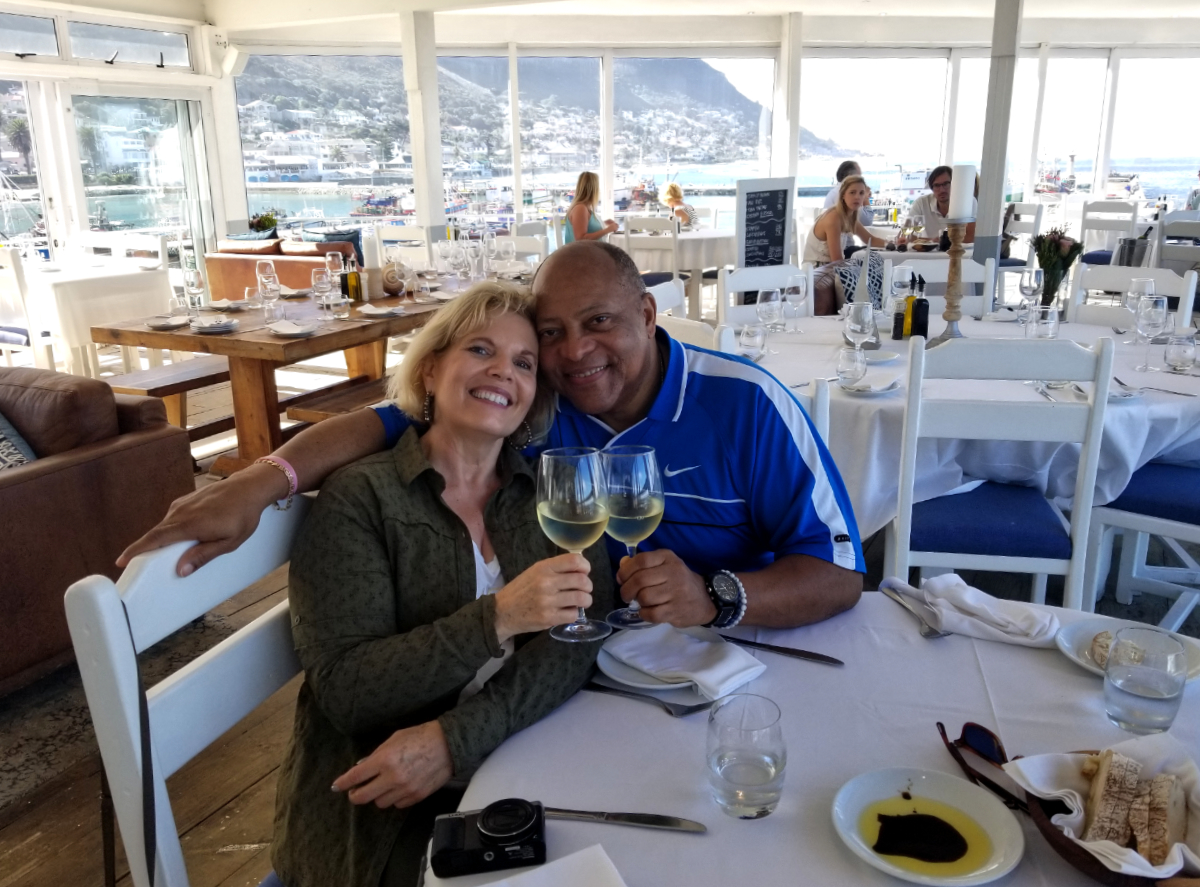“As I ate the oysters with their strong taste of the sea and their faint metallic taste that the cold white wine washed away, leaving only the sea taste and the succulent texture, and as I drank their cold liquid from each shell and washed it down with the crisp taste of the wine, I lost the empty feeling and began to be happy and to make plans.”
― Ernest Hemingway, A Moveable Feast
Cape of Good Hope and Spectacular Views
Laurel and I arose early. Our guide, Ann-Marie Breen, wanted to pick us up after breakfast. We were going to spend the day at the Cape of Good Hope, the most southwestern point of the African continent. The Cape of Good Hope is a rocky promontory once thought to be where the Indian and Atlantic Oceans meet. However, modern geographers have now confirmed that the true meeting point of the oceans is about 90 miles (145 kilometers) to the southeast at Cape Agulhas.

Historically, the Cape of Good Hope was a stopping point for ships with goods sailing between Europe and the European colonies in the east. Today, the Cape of Good Hope is part of eight protected areas in the region, and it has been designated as a World Heritage Site by UNESCO for the richness of its plant life.
The stunning drive from Cape Town winds its way along the coast past mountain cliffs and beautiful homes on the left and a spectacular ocean view on the right. The drive takes about an hour, passing 12 distinctive mountain outcroppings that the locals have named the 12 disciples.
We finally arrive at Table Mountain National Park, of which the Cape of Good Hope is a part. There are more than 1,100 species of indigenous plants that are unique to the area and grow nowhere else in the world. Ostriches, zebras, and Eland antelopes amongst other animals roam freely in the park.
We are going to a part of the park called Cape Point. There is a lighthouse at the top of the hill. You can climb the steep steps or take the Flying Dutchman funicular. We opted for the funicular, which rises 781 feet (238 meters) above the ocean. The view of the coastline from the lighthouse is stunning. Laurel and I stood taking in the view when suddenly a troop of three baboons strolled passed us. This is not unusual at the Cape, and they did not bother us. However, one must be careful if you’re around them, as they are wild animals. The baboons are highly intelligent and are also so bold that they will open car doors or go into purses and bags in search of food!
Penguins and then Lunch

Speaking of food, Ann-Marie suggested lunch, but first, she had a special treat for us. We drove a short way from Cape Point and stopped at Boulders Beach near Simon’s Town. Ann-Marie took us to see the cutest penguins. There were hundreds of them. These are African Penguins. That is what they are called, not just where they live. They used to be known as Jackass Penguins because of their distinctive braying, and they’re the only penguins found on the continent.
Lunch was at a charming oceanside restaurant named Harbour House, Kalk Bay. We were seated at a table overlooking the water crashing into the rocks, so it was inevitable that we would order seafood. Laurel and I decided to share a seafood platter, as the waitress said that there would be enough for two. That was an understatement. The seafood platter consisted of lobster, prawns, mussels, calamari, line fish, and a side of chips. The serving was worthy of a Las Vegas buffet.

We paired our seafood with a bottle of Remhoohte Wine Estate’s 2017 First Light Chenin Blanc (Platter’s Guide ★★★★, 13.40% alcohol). South Africa has exceeded France to become the largest grower and producer of Chenin Blanc. It is South Africa’s most-planted varietal. First Light is made with 100.00% Chenin Blanc grapes, 15.00% is aged in French oak barrels, while the remainder is fermented in steel tanks.

Pale gold in color, the nose has faint aromas of lime, green apple, and kiwi, tempered by a floral spice. The palate has high notes of mouth-watering limes and green apples. It is full-bodied, with a fresh taste and creamy acidity. What an incredible pairing!
We returned to the Cape Grace, our hotel in Cape Town, savoring an incredible meal and a delightful wine. Hours later my bride and I arose from a food-induced coma and wandered down to the bar. Gerald, our bartender, had advised us to make sure we went to another bar on the lower level of the hotel. We were given access to the hotel’s wine cellar! There were also over 300 varieties of Scotch and whiskeys. Laurel and I do not imbibe spirits, but the wines were a different matter!
Oldenburg Vineyards is a beautiful farm situated in the Banghoek Valley in the amphitheater of mountains above Stellenbosch that my bride and I had visited the day before. We began with the 2013 Oldenburg Rhodium, an International Wine and Spirits competition gold winner (Platter’s Guide ★★★★, 14.00% alcohol). The 2013 Oldenburg Rhodium is a classic Bordeaux blend of 53.00% Merlot, 40.00% Cabernet Franc, and 7.00% Malbec, matured in 50.00% new French oak for 19 months.
Rhodium is a rare metal used in the making of premium jewelry. Most of the world’s rhodium comes from South Africa, so this wine is appropriately named. The wine has fragrant aromas of dark fruit, predominantly blackberries, and plums, and has layered piquant notes of tobacco and cedar. This wine is medium- to full-bodied. The palate ushers in a mouthful of blackcurrants and fresh fruits, peppered with cherries and spices. The tannins dance effortlessly across the gums, and it is bound by an elegant acidity. This wine is the lover whose call you will always take.
Pinotage – South Africa’s Landmark Wine

Pinotage is a red wine grape that is almost exclusive to South Africa, having been bred there in 1925. Pinotage is a hybrid between the Pinot Noir and Cinsault grapes. Pinotage is a red wine that frequently is fragrant with notes of bananas and other tropical fruits. The downside is that Pinotage also sometimes has a nose of paint or acetone. Notwithstanding having its roots (okay, it is a bad pun) in France’s Rhône and Burgundy valleys, there is nothing French about it.
Eikendal’s 2016 (Platter’s Guide ★★★★☆and 13.00% alcohol), which is also a 100.00% Pinotage varietal. This wine is very deep red in color and abounded with a floral nose and pronounced fragrances of plums, blackberries, cherries, and pepper. I like to smell the glass again after it has been emptied, and this time, there was an unmistakable scent of vanilla, licorice, and smoke. This Pinotage is barrel-aged for 12 months.
On the palate is a medium- to full-bodied wine with hints of dark cherries and darker chocolate, all leading to an elegant finish that is lingering and pleasant. The Eikendal Pinotage has chewy tannins and it begged to be paired with grilled meats. It is a good wine that has characteristic smoky Pinotage notes.

We compared another Pinotage: The 2017 Southern Right Pinotage (Platter’s Guide ★★★★, 13.80% alcohol) is 100.00% Pinotage, completely matured in French cooperage for nine and one-half months. I braced myself for the typical acetone nose, but it was minimal. This wine is a deep red to purple in color, and its nose is pungent blackberries and other dark fruits, combined with a smoky, earthy quality. On the palate, is a fresh, medium-bodied wine with a clean finish. It is a Pinotage that will make South Africa proud.
The last wine of the evening was Bellingham Wines, The Bernard Series Bush Vine Pinotage 2016 (Platter’s Guide ★★★★☆, 14.00% alcohol). It too is 100.00% Pinotage. Fifty percent of the wine is matured in new French oak, and 50.00% is in second fill barrels for a period of 12 months. The color is the deepest red, and the nose is a red raspberry confit with intense black cherry aromas. Dry, with medium acidity and medium tannins, this wine is all about subtlety and nuance. There is a hint of oaky woodiness that lingers just beneath the surface. This is a delightfully complex and elegant wine!

What a wonderful end to an amazing day! What is more, we had one more bit of unexpected luck. As we left the wine cellar, the concierge stopped us and told us we had dinner reservations the next evening at a restaurant that was ranked as one of the top 25 in the world.






